
Authors: Demiralay EÇ, Andac M, Say R, Alsancak G, Denizli A
Article Title: Nickel(II)-imprinted monolithic columns for selective nickel recognition.
Publication date: 2010
Journal: Journal of Applied Polymer Science
Volume: 117
Issue: (6)
Page numbers: 3704-3714.
DOI: 10.1002/app.32269
Abstract: Ni2+-imprinted monolithic column was prepared for the removal of nickel ions from aqueous solutions. N-Methacryloyl-L-histidine was used as a complexing monomer for Ni2+ ions in the preparation of the Ni2+-imprinted monolithic column. The Ni2+-imprinted poly(hydroxyethyl methacrylate-N-methacryloyl-L-histidine) (PHEMAH) monolithic column was synthesized by bulk polymerization. The template ion (Ni2+) was removed with a 4-(2-pyridylazo) resorcinol (PAR):NH3-NH4Cl solution. The water-uptake ratio of the PHEMAH-Ni2+ monolith increased compared with PHEMAH because of the formation of nickel-ion cavities in the polymer structure. The adsorption of Ni2+ ions on both the PHEMAH-Ni2+ and PHEMAH monoliths were studied. The maximum adsorption capacity was 0.211 mg/g for the PHEMAH-Ni2+ monolith. Fe3+, Cu2+, and Zn2+ ions were used as competitive species in the selectivity experiments. The PHEMAH-Ni2+ monolithic column was 268.8, 25.5, and 10.4 times more selective than the PHEMAH monolithic column for the Zn2+, Cu2+, and Fe3+ ions, respectively. The PHEMAH-Ni2+ monolithic column could be used repeatedly without a decrease in the Ni2+ adsorption capacity. © 2010 Wiley Periodicals, Inc. J Appl Polym Sci, 2010
Template and target information: nickel ion, Ni(II)
Author keywords: adsorption, molecular imprinting, molecular recognition



Join the Society for Molecular Imprinting

New items RSS feed
Sign-up for e-mail updates:
Choose between receiving an occasional newsletter or more frequent e-mail alerts.
Click here to go to the sign-up page.
Is your name elemental or peptidic? Enter your name and find out by clicking either of the buttons below!
Other products you may like:
 MIPdatabase
MIPdatabase









